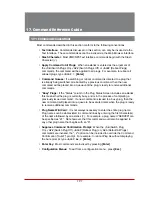
13-8
Operation via SNMP
13.6. Sending Traps via SNMP
Traps that report various unit conditions can be sent to an SNMP Management Station
from the VMR/NPS. The following traps are currently supported.
•
WarmStart
Trap – Trap indicating a warm start
•
ColdStart
Trap – Trap indicating a cold start
•
Test
Trap – Test trap invoked by user via the Text Interface (CLI.)
The VMR/NPS can send an SNMP trap to notify you when any of the available alarm
functions have been triggered. In all cases except the Power Cycle Alarm, there will be
one trap sent when the alarm is triggered, and a second trap sent when the alarm is
cleared. For more information on alarm functions, please refer to Section 8.
•
Alarm
Trap – Trap indicating an alarm condition. A trap with a unique enterprise
OID is defined for every possible alarm in the system, under which several specific
trap-types are defined to indicate the setting or clearing of that particular alarm
condition.
•
overCurrentInitialSetTrap
- (VMR Series Units Only) Indicates that the Over
Current (Initial) Alarm has been triggered.
•
overCurrentInitialClearTrap
- (VMR Series Units Only) Indicates that the
Over Current (Initial) Alarm has been cleared.
•
overCurrentCriticalSetTrap
- (VMR Series Units Only) Indicates that the
Over Current (Critical) Alarm has been triggered.
•
overCurrentCriticalClearTrap
- (VMR Series Units Only) Indicates that the
Over Current (Critical) Alarm has been cleared.
•
overTemperatureInitialSetTrap
- Indicates that the Over Temperature
(Initial) Alarm has been triggered. The trap will also include a numerical value that
indicates the current unit temperature.
•
overTemperatureInitialClearTrap
- Indicates that the Over Temperature
(Initial) Alarm has been cleared.
•
overTemperatureCriticalSetTrap
- Indicates that the Over Temperature
(Critical) Alarm has been triggered. The trap will also include a numerical value that
indicates the current unit temperature.
•
overTemperatureCriticalClearTrap
- Indicates that the Over Temperature
(Critical) Alarm has been cleared.
•
pingNoAnswerSetTrap
- Indicates that the Ping No Answer Alarm has been
triggered. The trap will also include a numerical value that indicates the IP address
of the device that failed to respond to the ping command.
•
pingNoAnswerClearTrap
- Indicates that the Ping No Answer Alarm has been
cleared.
•
lockoutSetTrap
- Indicates that the Invalid Access Lockout Alarm has been
triggered. The trap will also include a numerical value that indicates the number of
the serial port where the lockout occurred.
•
lockoutClearTrap
- Indicates that the Invalid Access Lockout Alarm has been
cleared.
















































